Abstract
With the development of the economy in China, the tourism industry has become a form of daily entertainment for citizens. Commercial pedestrianized blocks have been designed as recreational centers for tourists, serving as outdoor public space and scenic spots. The use of these regions is directly determined by the outdoor thermal environment. So far, few studies have been conducted on tourists’ thermal experience in commercial pedestrianized blocks, especially in the hot and humid region of southern China. Using field measurement and numerical simulation of a commercial pedestrianized block in Fo Shan, China, to research tourists’ thermal experience under different conditions, the final results of this study could help to select the most suitable time for tourist travel and help local managers to improve the thermal environment.
1. Introduction
As the economy develops in China, tourism has become the most important source of entertainment in citizens’ daily lives. In addition, tourism is also a very important factor in the increasing employment and income of many cities in China [1]. Notably, the climate and weather in different seasons will directly affect the tour schedules of tourists; considering tourists’ thermal experience is very necessary, especially in extreme summer conditions. A suitable thermal environment could increase the number of tourists. When tourists are exposed to daytime sunshine that may cause thermal pressure, especially under extreme high temperatures, tourists’ health can be badly influenced [2]. The integration of the thermal environment and physical beauty has the potential to greatly improve tourist destinations [3].
When considering tourists’ thermal experience in different climates, choosing a suitable thermal index to analyze tourists’ thermal experience is necessary. To date, the discomfort index [4], wind-chill index [5], apparent temperature [6], and tourism climate index (TCI) [7] have been developed to evaluate thermal environments. These indices all consider various meteorological parameters, but consideration of the heat balance of the human body and human thermal physiology are still necessary. Therefore, based on former research, a new climate tourism information scheme (CTIS) index was developed to combine the energy balance of the human body and meteorological data [8]. Meanwhile, in accordance with the CTIS, some new indices to assess humans’ thermal comfort have been put forward, including standard effective temperature (SET) [9], effective temperature (ET) [10], universal thermal climate index (UTCI) [11], outdoor standard effective temperature (OUT-SET) [12], physiological equivalent temperature (PET) [13], and so on. The PET is based on the thermophysiological energy balance in the human body, which is also assessed by Germany’s VDI (Association of German Engineers) standard for its accuracy for calculating human thermal experience [14].
So far, some researchers have found that street morphology, including sky view factor (SVF) and aspect ratio (H/W), can affect the outdoor thermal environment [15,16,17]. The former is an index, ranging from zero to one, that describes the incoming daytime solar radiation, and the latter describes a proportional relationship between the width of a street and the height of the buildings. A higher H/W and lower SVF can contribute to improved outdoor thermal comfort. In addition, vegetation on both streets and rooftops can also ameliorate the thermal environment through evapotranspiration effects [18,19,20,21,22,23,24,25,26,27,28,29,30,31]. Reducing the percentage of hardened ground also can change inner microclimates [18,32,33].
Most previous studies on this aspect of tourism have been conducted in America [34] and Britain [35,36,37], Germany [38], the Netherlands [39], few studies has been conducted in southern China [1]. In addition, most studies to date have focused on the urban level, and very few have focused on the commercial pedestrian block. Due to its economic value, urban tourism has become a significant factor in the financial income of a city. Most previous studies on this topic have collected data from different meteorological stations and put forward thermal comfort conditions regardless of numerical simulation. In this study, besides the on-site measurements, a simulated ENVI-met tool was also used to evaluate outdoor thermal experience, thus creating a thermal calendar to help tourists schedule their trips and help managers and designers to understand the cooling effects of different strategies.
2. Methods
2.1. Research Site
There are five classified climate zones in China: temperate zone, cold zone, severe cold zone, hot summer and warm winter zone, and hot summer and cold winter zone [40]. Fo Shan is a famous historical and cultural city in China, and also has a hot and humid climate in summer (hot summer and warm winter zone) (Figure 1). The Ling Nan Tian Di block is one of the most famous scenic spots in this city. According to the statistical data collected by local administration, it attracts many tourists every year (Figure 2) [41]. It is necessary to design a suitable environment for tourists.
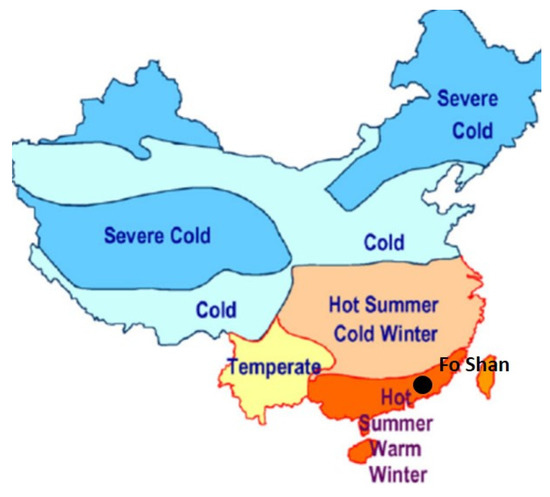
Figure 1.
The climate classification of Fo Shan.

Figure 2.
The location of the research site.
2.2. Research Period
As mentioned above, the current study aimed to provide information about the most suitable traveling time for tourists. To this end, the researchers wished to assess the thermal environment both when there were the most tourists and the hottest period of a year. Based on the local published weather data, Fo Shan city experiences the highest air temperatures in July [42]. Table 1 shows the air temperature in July 2016.

Table 1.
The weather conditions on the measured days.
In this study, on-site measurement was conducted at the research site to make sure the validation of the numerical simulation by ENVI-met was done at the same time as the on-site measurement. The final results were used to determine the outdoor thermal level of the selected site.
2.3. On-Site Measurement
Outdoor microclimate has a strong effect on tourists’ thermal comfort and affect their activity. This investigation conducts 7 points in accordance with the different geometry (Figure 3). In this study, the meteorological data including wind speed, air temperature and relative humidity are collected by the fixed instruments (Table 2).

Figure 3.
The selected points in this study.

Table 2.
The introduction of the measured instruments.
Each point is measured for the typical day (hottest day, 24 July 2016), in addition, all the points are measured simultaneously from 9:00 a.m. to 5:00 p.m. The principles for fixing the instruments are as following:
- Each instrument is fixed at a 1.5 m height (average pedestrian level) from the surface.
- Each instrument is covered by a shelter to prevent the influence on air temperature by solar radiation at daytime.
2.4. Numerical Simulation
As mentioned in many studies, numerical simulations can overcome the shortcomings of on-site measurement. In this study, the simulation was conducted using ENVI-met, which is a reliable tool for simulating outdoor thermal environments. As a point of difference from other software, the trees and grass in this software are set as biological bodies which can interact with the ambient environment by evapotranspiration. The configurations of the vegetation in this study were based on the leaf area density (LAD) and leaf area index (LAI), which is defined as a dimensionless value of the leaf area per unit of ground area, and explains the ability to impede incoming solar radiation. The following equation shows the relationship between the two [43,44]:
where is the vertical grid size (m) and h is the height of the tree (m). According to the field survey, the study region included two kinds of border tree, Bischofia javanica, and Ficus microcarpa. Detailed information on these two kinds of tree is shown in Figure 4 and Figure 5.

Figure 4.
Vertical configuration of Bischofia javanica. LAD: leaf area density.
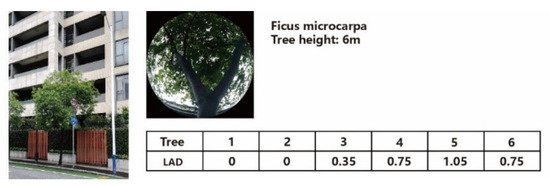
Figure 5.
Vertical configuration of Ficus microcarpa.
The initial input data used in this work are displayed in Table 3.

Table 3.
Initial data for simulation.
The simulated model of the selected site is shown in Figure 6.
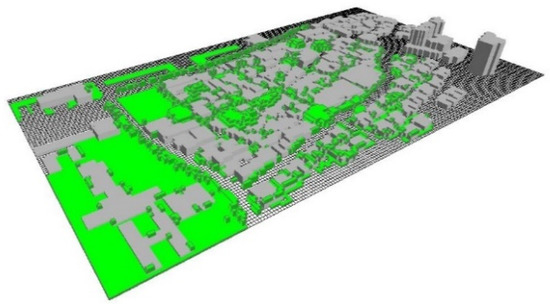
Figure 6.
The simulated model of this study.
The classification of thermal perception and PET values of the hot summer and warm winter climate zone is shown in Table 4 [45,46].

Table 4.
The physiological equivalent temperature (PET) values and humans’ thermal perceptions [45,46].
2.5. Validation
Even though the simulated accuracy of the ENVI-met has been tested in many studies, validation between the measured and simulated data was still necessary. In order to maximize the validity of the simulated results of this study, all the selected points of the simulation model were validated simultaneously.
The regression correlation [46] (Figure 7) of the R2 of the wind velocity was between 0.7307 and 0.9001, the R2 of the air temperature was from 0.7544 to 0.9847, and the values for relative humidity were between 0.7664 and 0.9813. The final linear regression results proved that the ENVI-met was a reliable software choice for this study.
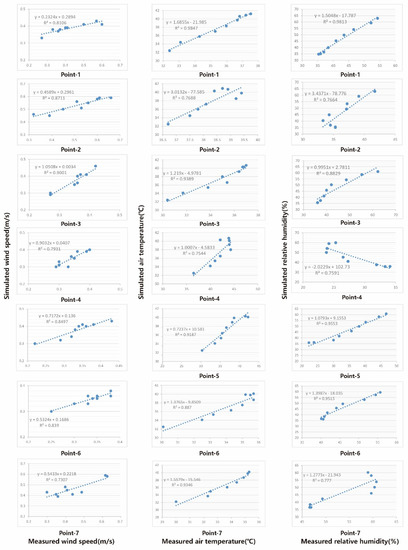
Figure 7.
The correlation between three kinds of data [46].
3. Results
3.1. Tourists’ Thermal Experience under the Existing Scenario
As mentioned above, the PET index was used in this study to evaluate tourists’ thermal experiences in extreme summer. The thermal environment during the measured day is shown in Figure 8, which explains that the whole block reached “hot” and “very hot” levels from 10:00 to 19:00, meaning that nearly the entire day was unsuitable for tourist activities [45].
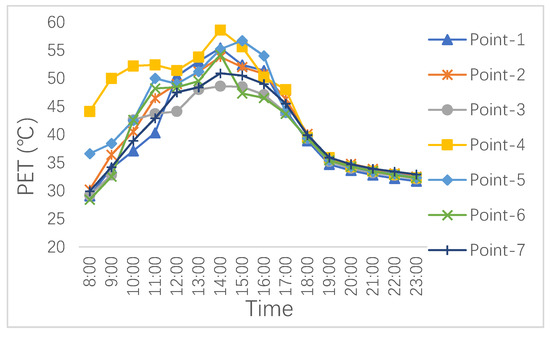
Figure 8.
The thermal environment of the block under existing scenario [45].
Based on the existing thermal situation, a new thermal calendar has been put forward for tourists [45], which is in accordance with PET values and thermal perceptions of the hot summer and warm winter climate zone. In this calendar, each color represents a 2 °C interval of the PET value. “Very hot” and “hot” are defined as “unsuitable”, “warm” as “fairly suitable”, and “slightly warm” as “suitable”. Figure 9 shows the thermal comfort calendar under the existing scenario. As shown in this figure, from 8:00 to 9:00, nearly all the regions are at suitable and fairly suitable levels, except Point 4. From 10:00 to 19:00 p.m., the whole region is uncomfortable for visiting, and Point 4 has the worst thermal environment. After 19:00, all points can be easily visited.
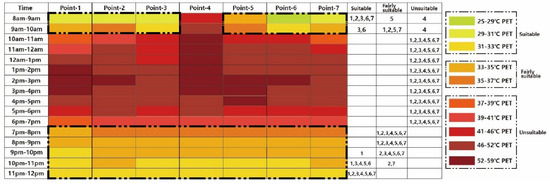
Figure 9.
The thermal calendar under existing scenario [45].
3.2. New Thermal Calendars under New Cases
Based on the existing scenario, we put forward four new cases able to create a cooling effect and extend visiting hours. Table 5 and Figure 10 show the detailed information.

Table 5.
The new cases.

Figure 10.
The cases: various different coverage ratios.
Case 1 aims at increasing the average building height, with its corresponding effect of improving thermal comfort. According to the local design specifications, the green coverage ratio in the built environment cannot be less than 25% of this whole region [47]. In Case 2, the tree coverage ratio is increased to 25%. Case 3 is focused on the cooling effect of a ground paving material with higher albedo. The last case combines all the mentioned cases together, and their functions were evaluated. As shown in Figure 10, in the base case (existing scenario), the total buildings occupy 63.3% of the whole region, the vegetation coverage ratios of Bischofia javanica and Ficus microcarpa are 7.5% and 8%, and the rest of the region (21.2%) is the ground surface. In Case 1, increasing the average building height cannot change the coverage ratio, so the results were similar to the base case. In Case 2, the coverage ratio of Bischofia javanica was increased to 17%, and that of Ficus microcarpa was increased to 17.5%. In addition, in Case 3, the ground surface was replaced with a higher albedo. In the last case, increasing the average building height and vegetation coverage ratio and replacing paving material were all applied.
Here, we discuss the impacts of the new cases on tourists’ thermal experience. The hourly diagram of ∆PET values of the selected points is shown in Figure 11. As expected, the magnitude of PET reduced under the new cases, that is to say, all new cases could contribute to improving outdoor thermal comfort (positive ∆PET). Figure 11a shows that for the ∆PET of Point 1, the last case (Case 4) has the strongest effect of reducing PET at daytime, with reductions ranging from 0.2 °C to 8.1 °C due to the building shadow and vegetation cooling effect. At daytime, the cooling effect of Bischofia javanica is much better than Ficus microcarpa because of the higher leaf area index (LAI); trees with higher LAI can better lower thermal experience through transpiration. Case 3 was not as effective as other cases at improving comfort. The ∆PET curve of Point 2 (Figure 11b) was similar to that of Point 1, however, the magnitude was less than that of Point 1. Because of the shared street orientation and similar geometry, the curve of Point 3 (Figure 11c) was similar to those of the aforementioned two points. For other canyon points (Figure 11d,e), the cooling effect of building shadow and vegetation was much better than for all aforementioned points. Under Case 4, the hourly ∆PET of Point 5 and Point 6 ranged, respectively, from 0.3 °C to 8.9 °C and 0.3 °C to 8.3 °C during the daytime. Case 3 was not effective at improving thermal comfort. For open space, the hourly variation of ∆PET is shown in Figure 11d,g. The time evolution of ∆PET at the two selected points was a little different; Point 4 had three peaks during the daytime, while Point 7 had two peaks. Moreover, unlike canyon space, Case 3 did not obviously reduce PET during the daytime. The effect of Case 4 on the two points was a respective reduction of PET by 14.9 °C and 8.6 °C.
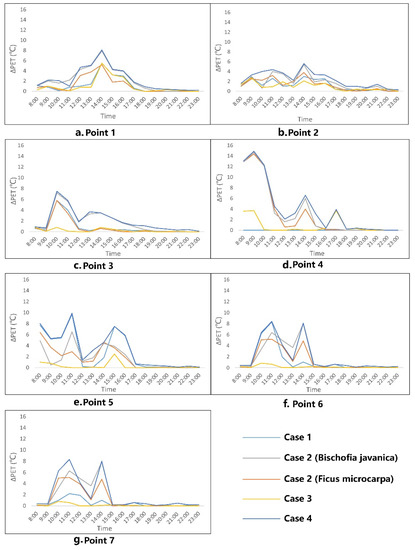
Figure 11.
Thermal comfort improvement under different cases: (a) point 1; (b) point 2; (c) point 3; (d) point 4; (e) point 5; (f) point 6; (g) point 7.
In accordance with the new simulated outcome under increasing building height (Case 1), it was noted that the canyon with higher aspect ratio (H/W) (Figure 12) effectively reduced PET during the daytime. Unlike in the old thermal comfort calendar (base case) (Figure 9), from 8:00 to 9:00 in the morning, all points except Point 4 were suitable. Like in the existing scenario, after 19:00 all the points registered a good visiting environment.
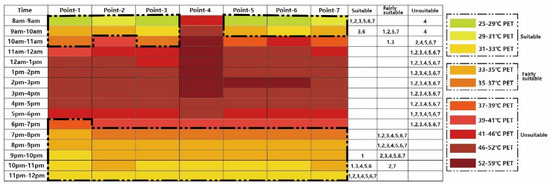
Figure 12.
Thermal comfort calendar for tourists under Case 1.
The simulated results showed that different tree species will have different cooling effects during the daytime. As Figure 13 shows, increasing the vegetation coverage ratio of this zone could broaden the visiting times for tourists compared to the existing scenario: Point 4 becomes able to be visited from 8:00 to 10:00, and Points 1–3 are all fairly suitable from 10:00 to 11:00. After 19:00, the difference between new thermal calendar and existing scenario is not obvious.

Figure 13.
Thermal comfort calendar for tourists under Case 2 (Ficus microcarpa).
As mentioned above, trees with a higher LAI will have a much greater effect on reducing PET during the daytime. As expected, the cooling effect of Bischofia javanica was much better than that of Ficus microcarpa. As shown in Figure 14, all the selected points were suitable from 8:00 to 9:00 in this case. Compared to the Ficus microcarpa scenario, even in the unsuitable period, Bischofia javanica can alleviate heat stress effectively.
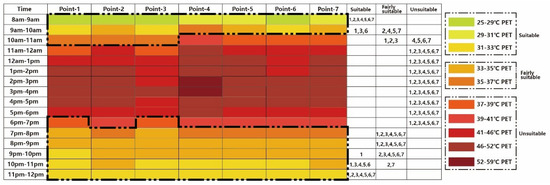
Figure 14.
Thermal comfort calendar for tourists under Case 2 (Bischofia javanica).
Compared to the existing scenario, changing the paving material (Figure 15) did not effectively expand the cool time for tourists.
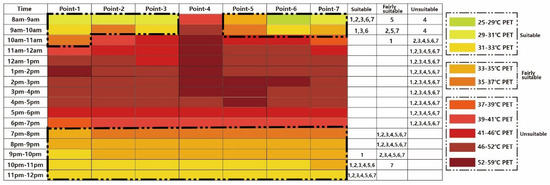
Figure 15.
Thermal comfort calendar for tourists under Case 3.
Figure 16 shows the thermal calendar under Case 4. Compared to all the aforementioned calendars, the last case had the strongest influence on expanding the visiting time for tourists. Except for Point 4 and Point 7, other points could also be visited from 10:00 to 11:00.
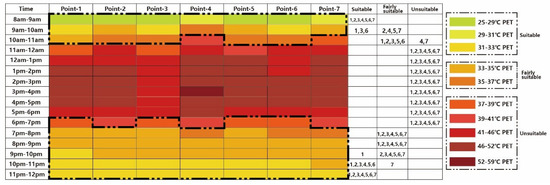
Figure 16.
Thermal comfort calendar for tourists under Case 4.
4. Conclusions
The present study intended to evaluate tourists’ thermal experience in the microclimate of the valuable commercial pedestrianized-zone of Fo Shan city on the hottest day of a year. According to the simulated results under the existing scenario, almost none of the selected points were within the comfort zone during the daytime between 10:00 and 19:00. In addition, in the early morning (8:00 to 10:00), except for the open space (Point 4), other points were all in the comfortable zone. From 19:00 to 00:00, the whole zone is comfortable. The thermal calendars under the proposed new cases showed that increasing building height (Case 1) could effectively improve thermal comfort and expand the cool time for tourists in the canyon space, in which added nearly an extra hour for visiting. In Case 2 (Ficus microcarpa), the cooling effect not only improved human thermal comfort in the canyon space, but also in open space; in this case, the visiting time of the whole commercial region can be extended by an hour in the morning. Compared to Case 2 (Ficus microcarpa), Case 2 (Bischofia javanica) had a higher LAI, and the final result showed that it had a better cooling effect. Case 3 showed that the cooling effect of pavement material (a higher albedo of ground surface), even when it alleviated heat stress did not extend the visiting window by much. The final case (Case 4) showed the highest cooling effect, in which the visiting time for tourists could be extended by two hours in the morning. The final results could help tourists to choose a comfortable period for their visiting, and also provide urban planning recommendations.
Based on the conclusions of this study, our suggestions are: (1) Increased coverage ratio of three-story buildings. Increased average building height can effectively impede solar radiation during the daytime, which will always provide a benefit for outdoor environments. (2) The vegetation and landscape represent an influential factor; our final results proved that there is an obvious correlation between the trees and the reduction of PET values. In Fo Shan city, it is recommended to plant trees with a higher leaf area index (LAI) (Ficus microcarpa, Bischofia javanica, Camphora officinarum, Chinese redbud, Carthamus tinctorious, and so on). (3) Reduced percentage of hardened ground with lower albedo; designers can use paving materials with higher albedo to improve the outdoor thermal environment.
In addition, there were some limitations to our study. The simulated air temperature showed a 5.5 °C deviation from on-site data, which was attributed to the inability of the models to simulate aspects of reality like the façades of buildings, and the limited resolutions in ENVI-met. This study evaluated outdoor thermal comfort under the trees currently existing at the research site; future work should consider more vegetation.
Author Contributions
Conceptualization, X.M.; methodology, X.M.; software, X.M.; validation, and M.W.; formal analysis, L.Z.; investigation, L.Z. and X.M.; resources, X.M.; data curation, X.M.; writing—original draft preparation, L.Z. and X.M.; writing—review and editing, J.Z. and M.W.; visualization, M.W.; supervision, J.Z.; project administration, J.Z.; funding acquisition, J.Z.
Funding
This research was funded by National Natural Science Foundation of China (51678058) and the 13th-Five National S&T Pillar Program Key Projects Sub topics (2016YFC0700401-01).
Conflicts of Interest
The authors declare no conflict of interest.
References
- Lin, T.P.; Matzarakis, A. Tourism climate information based on human thermal perception in Taiwan and Eastern China. Tour. Manag. 2011, 32, 492–500. [Google Scholar] [CrossRef]
- Linares, C.; Diaz, J. Impact of high temperature on hospital admissions: Comparative analysis with previous studies about mortality. Eur. J. Public Health 2008, 18, 317–322. [Google Scholar] [CrossRef] [PubMed]
- Hamilton, J.M.; Tol, R.S. The impact of climate change on tourism in Germany, the UK and Ireland: A simulation study. Reg. Environ. Chang. 2007, 7, 161–172. [Google Scholar] [CrossRef]
- Wang, S.; He, Y.; Song, X. Impacts of climate warming on alpine glacier tourism and adaptive measures: A case study of Baishui Glacier No. 1 in Yulong Snow Mountain, Southwestern China. J. Earth Sci. 2010, 21, 166–178. [Google Scholar] [CrossRef]
- Steadman, R.G. Indices of windchill of clothed persons. J. Appl. Meteorol. 1971, 10, 674–683. [Google Scholar] [CrossRef]
- Steadman, R.G. The assessment of sultriness. Part I. A temperature humidity index based on human physiology and clothing science. J. Appl. Meteorol. 1979, 18, 861–873. [Google Scholar] [CrossRef]
- Mieczkowski, Z. The tourism climate index: A method for evaluating world climates for tourism. Can. Geogr. 1985, 29, 220–233. [Google Scholar] [CrossRef]
- Lin, T.P.; Matzarakis, A.; Hwang, R.L. Shading effect on long-term outdoor thermal comfort. Build. Environ. 2010, 45, 213–221. [Google Scholar] [CrossRef]
- Gagge, A.P.; Fobelets, A.P.; Berglund, L.G. A standard predictive index of human respond to the thermal environment. ASHARE Trans. 1986, 92, 709–731. [Google Scholar]
- De Dear, R.; Pickup, J. An outdoor thermal environment index (OUT_SET*)-Applications. In Biometeorology and Urban Climatology at the Turn of the Millenium. Selected Papers from the ICB-ICUC’99 Conference, Sydney, WCASP-50, WMO/TD No. 1026; de Dear, R.J., Kalma, J.D., Oke, T.R., Auliciems, A., Eds.; World Meteorological Organization: Geneva, Switzerland, 2000. [Google Scholar]
- Ayman, H.A.M. Analysis of the microclimatic and human comfort conditions in an urban park in hot and arid regions. Build. Environ. 2011, 46, 2641–2656. [Google Scholar]
- Spagnolo, J.; de Dear, R.J. A field study of thermal comfort in outdoor and semi-outdoor environments in subtropical Sydney Australia. Build. Environ. 2003, 38, 721–738. [Google Scholar] [CrossRef]
- Höppe, P. The physiological equivalent temperature–A universal index for the bio-meteorological assessment of the thermal environment. Int. J. Biometeorol. 1999, 43, 71. [Google Scholar] [PubMed]
- Höppe, P. Heat balance modelling. Experientia 1993, 49, 741–746. [Google Scholar] [CrossRef] [PubMed]
- Pearlmutter, D.; Berliner, P.; Shaviv, E. Integrated modeling of pedestrian energy exchange and thermal comfort in urban street canyons. Build. Environ. 2007, 42, 2396–2409. [Google Scholar] [CrossRef]
- Krüger, E.; Pearlmutter, D.; Rasia, F. Evaluating the impact of canyon geometry and orientation on cooling loads in a high-mass building in a hot dry environment. Appl. Energy 2010, 87, 2068–2078. [Google Scholar] [CrossRef]
- Cao, A.; Li, Q.; Meng, Q. Effects of orientation of urban roads on the local thermal environment in guang zhou city. Procedia Eng. 2015, 121, 2075–2082. [Google Scholar] [CrossRef]
- Zhang, Y.; Du, X.; Shi, Y. Effects of street canyon design on pedestrian thermal comfort in the hot-humid area of China. Int. J. Biometeorol. 2017, 61, 1421–1432. [Google Scholar] [CrossRef]
- Morakinyo, T.E.; Lam, Y.F. Simulation study on the impact on tree-configuration, planting pattern and wind condition on street-canyon’s micro-climate and thermal comfort. Build. Environ. 2016, 103, 262–275. [Google Scholar] [CrossRef]
- Morakinyo, T.E.; Kong, L.; Lau, K.K.-L.; Yuan, C.; Ng, E. A study on the impact of shadow-cast and tree species on in-canyon and neighborhood’s thermal comfort. Build. Environ. 2017, 115, 1–17. [Google Scholar] [CrossRef]
- Shafique, M.; Reeho, K.; Muhammad, R. Green roof benefits, opportunities and challenges—A review. Renew. Sustain. Energy Rev. 2018, 80, 757–773. [Google Scholar] [CrossRef]
- Jim, C.Y.; Lilliana, L.P. Weather effect on thermal and energy performance of an extensive tropical green roof. Urban For. Urban Green. 2012, 11, 73–85. [Google Scholar] [CrossRef]
- Wilkinson, S.; Feitosa, R.C. Thermal performance of green roof retrofit. In Green Roof Retrofit: Building Urban Resilience; Wiley-Blackwell: Hoboken, NJ, USA, 2016; pp. 62–84. [Google Scholar]
- Muhammad, S.; Xue, X.; Luo, X. An overview of carbon sequestration of green roofs in urban areas. Urban For. Urban Green. 2019, 126515. [Google Scholar]
- Oberndorfer, E.; Lundholm, J.; Bass, B.; Coffman, R.R.; Doshi, H.; Dunnett, N.; Rowe, B. Green roofs as urban ecosystems: Ecological structures, functions, and services. BioScience 2007, 57, 823–833. [Google Scholar] [CrossRef]
- Xing, Q.; Hao, X.; Lin, Y.; Tan, H.; Yang, K. Experimental investigation on the thermal performance of a vertical greening system with green roof in wet and cold climates during winter. Energy Build. 2019, 183, 105–117. [Google Scholar] [CrossRef]
- Williams, N.S.; Lundholm, J.; Scott MacIvor, J. Do green roofs help urban biodiversity conservation. J. Appl. Ecol. 2014, 51, 1643–1649. [Google Scholar] [CrossRef]
- Shafique, M.; Reeho, K. Application of green-blue roof to mitigate heat island phenomena and resilient to climate change in urban areas: A case study from Seoul, Korea. J. Water Land Dev. 2017, 33, 165–170. [Google Scholar] [CrossRef]
- Zhang, G.; He, B.-J.; Zhu, Z.; Dewancker, B.J. Impact of morphological characteristics of green roofs on pedestrian cooling in subtropical climates. Int. J. Environ. Res. Public Health 2019, 16, 179. [Google Scholar] [CrossRef]
- Wu, Z.; Kong, F.; Wang, Y.; Sun, R.; Chen, L. The impact of greenspace on thermal comfort in a residential quarter of Beijing, China. Int. J. Environ. Res. Public Health 2016, 13, 1217. [Google Scholar] [CrossRef]
- Wu, W.; Ren, H.; Yu, M.; Wang, Z. Distinct Influences of Urban Villages on Urban Heat Islands: A Case Study in the Pearl River Delta, China. Int. J. Environ. Res. Public Health 2018, 15, 1666. [Google Scholar] [CrossRef]
- Erell, E.; Pearlmutter, D.; Boneh, D.; Kutiel, P.B. Effect of high-albedo materials on pedestrian heat stress in urban street canyons. Urban Clim. 2014, 10, 367–386. [Google Scholar] [CrossRef]
- Bowler, D.E.; Buyung-Ali, L.; Knight, T.M.; Pullin, A.S. Urban greening to cool towns and cities: A systematic review of the empirical evidence. Landsc. Urban Plan. 2010, 97, 147–155. [Google Scholar] [CrossRef]
- Ballantyne, E.R.; Hill, R.K.; Spencer, J.W. Probit analysis of thermal sensation assessments. Int. J. Biometeorol. 1977, 21, 29–43. [Google Scholar] [CrossRef] [PubMed]
- Bigano, A.; Hamilton, J.M.; Tol, R.S.J. The Impact of Climate on Holiday Destination Choice; Working Papers 04; Fundazione Eni Enrico Mattei: Hamburg, Germany, 2005. [Google Scholar]
- De Freitas, C.R. The climate-tourism relationship and its relevance to climate change impact assessment. In Tourism, Recreation and Climate Change; Hall, C.M., Higham, J., Eds.; Channel View Publications: Clevedon, UK, 2005; pp. 29–43. [Google Scholar]
- Hwang, R.L.; Lin, T.P. Thermal comfort requirements for occupants of semi-outdoor and outdoor environments in hot-humid regions. Archit. Sci. Rev. 2007, 50, 60–67. [Google Scholar] [CrossRef]
- Lindberg, F.; Holmer, B.; Thorsson, S. SOLWEIG 1.0 e modelling spatial variations of 3D radiant fluxes and mean radiant temperature in complex urban settings. Int. J. Biometeorol. 2008, 52, 697–713. [Google Scholar] [CrossRef]
- Taleghani, M.; Tenpierik, M.; van den Dobbelsteen, A.; Sailor, D.J. Heat mitigation strategies in winter and summer: Field measurements in temperate climates. Build. Environ. 2014, 81, 309–319. [Google Scholar] [CrossRef]
- Thermal Design Code for Civil Buildings, GB 50176–51993; Ministry of Housing and Urban-rural, Development of the People’s Republic of China: Beijing, China, 1993.
- Cultural Heritage and Tourism Organization of Fo Shan. Available online: http://www.foshantravel.cn/ (accessed on 10 December 2019).
- Meteorological Organization Country. Available online: http://www.irimo.ir (accessed on 10 December 2019).
- Jamei, E.; Rajagopalan, P. Urban development and pedestrian thermal comfort in Melbourne. Sol. Energy 2017, 144, 681–698. [Google Scholar] [CrossRef]
- Morakinyo, T.E.; Lau, K.K.-L.; Ren, C.; Ng, E. Performance of Hong Kong’s common trees species for outdoor temperature regulation, thermal comfort and energy saving. Build. Environ. 2018, 137, 157–170. [Google Scholar] [CrossRef]
- Ma, X.; Fukuda, H.; Zhou, D.; Wang, M. A Study of the Pedestrianized Zone for Tourists: Urban Design Effects on Humans’ Thermal Comfort in Fo Shan City. S. China Sustain. 2019, 11, 2774. [Google Scholar] [CrossRef]
- Ma, X.; Fukuda, H.; Zhou, D.; Wang, M. The evaluation of outdoor thermal sensation and outdoor energy efficiency of a commercial pedestrianized zone. Energies 2019, 12, 1324. [Google Scholar] [CrossRef]
- CSADI. The Commercial Building Design Specification. Available online: https://wenku.baidu.com/view/4c4a9df76529647d272852bb.html (accessed on 10 December 2019).
© 2019 by the authors. Licensee MDPI, Basel, Switzerland. This article is an open access article distributed under the terms and conditions of the Creative Commons Attribution (CC BY) license (http://creativecommons.org/licenses/by/4.0/).